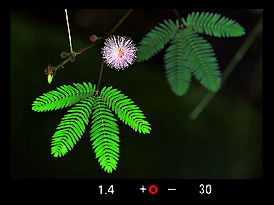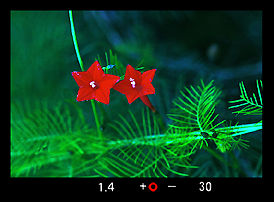Copyright ©-free Images collection. 2001, leofoo (38 K Jpeg) Malaysian Internet Resources
In the first place, I am not sure why they are called "Micro-Nikkor" instead of "Macro-Nikkor" while the latter has a far more universal photographic term closer to their basic functions. However, I don't intend to challenge something which has such a long history and rich background behind it and so, just let it be and called them as "Micro-Nikkor", okay ?
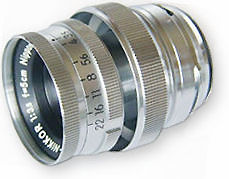 |
Anyway, as mentioned earlier, these close focusing lenses were originated from the rangefinder days back in October, 1956 where an exciting breakthrough happened with a commercial production lens, RF 5cm f/3.5 Micro-Nikkor with true close focusing ability was being offered to photographers for the first time. A few years later when the reflex Nikon F camera system was eventually being introduced, a similar lens with a F-bayonet mount was virtually a replica of the original lens made for the Nikon rangefinder with a identical optical formula (no joke, even the rangefinder's version can be adapted to a Nikon F via a RF tube !). |
Credit: Image courtesy of Mr. Serhiy <jrpv@gmx.net>Copyright © 2002, All rights reserved.
The first true Micro-Nikkor lens designed specifically for reflex viewing was only being introduced by Nikon two years later in August, 1961 where a 5.5cm f/3.5 Micro-Nikkor-P Preset lens was replacing the older converted lens. See below for a short descriptions of the early F-mount Micro-Nikkor auto lenses:
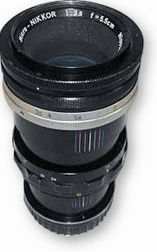 |
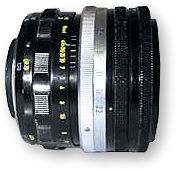 |
5.5cm f/3.5-32 Micro-Nikkor-P Preset (1961) |
- Michael Liu -
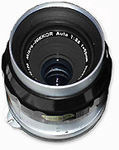 |
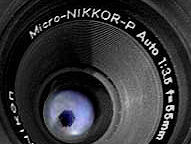 |
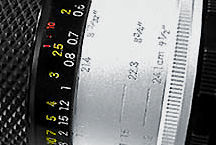 |
One of the earliest non-Ai 55mm f/3.5 Micro-Nikkor-P which even has the extension range, magnification also engraved on the lens barrel. |
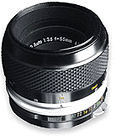 |
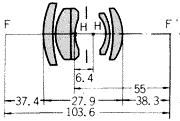 |
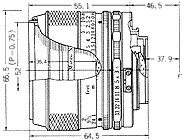 |
Optical construction of one of the early 50mm f/3.5 Micro-Nikkor lens. |
Subsequent years, the early design of the Micro-Nikkor has gone through many stages of refine and improvements. Many of these chances occurred between the period of 1965 to 1979. The original 50mm focal length of those older Micro Nikkor was slightly extended to 55mm and also the maximum aperture was a much brighter f/2.8 instead of f/3.5. The 55 mm Micro-Nikkor lens can actually be regarded as an ALL ROUND normal lens (it also has a "normal" picture coverage of 43° -which corresponding to any normal lens of 46°) , meaning it is neither telephoto or retrofocus. If you hold it at arms length to see the entrance and exit pupils, they are about the same size.
The Helicoid of the 55mm MICRO NIKKOR has an unusually long range of movement 27.5mm, which is half the lens focal length. When focused on the nearest possible subject, magnification can reach 0.5X with no extension other than that provided by the built-in Helicoid. The closest marked focusing distance on the lens is 0.241 meters or 9.5 ". For even closer focusing and higher magnification ratio can be achieved by adding the lens-to-film extension using a bellow unit or a selection of simpler-to-operate Nikon extension rings/tubes. There are plenty of combinations with varying degree of magnification ratio when use with PK rings or extension tubes while the bellow unit(s) offers a more flexible and seamless of ratios. Two of the most popular Extension Tubes for the manual focus Micro-Nikkor lenses during the '80 are PK-13 and PN-11 as they are matched tubes for two of the popular focal length of Micro-Nikkor lenses at 55mm and 105mm.
Copyright ©-free Images collection. 2001, leofoo (38 K Jpeg) Malaysian Internet Resources
The Micro-Nikkor 55mm f/2.8 lens is brighter than earlier non-Ai f/3.5 version while has been enjoying a fine reputation for its optical quality. It has obviously benefited from the deployment of Nikon's Close-Range Correction System in its optical design which is used to maintain equally high close focusing performance at its minimum focusing range. This lens has a top rated built quality too. The only draw back you can picked on it is perhaps the restrictive working distance where at its magnification of 1X life size, the working distance is only about 57mm as compared to a more comfortable range of 0.47 m (1.55ft) provides by its 105mm counterpart.
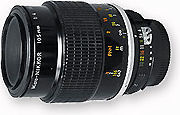 |
 |
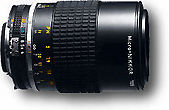 |
The razor sharp Micro-Nikkor 105mm f/4.0 has a simple and straight forward optical design of 5 elements in 3 groups and it was always been many photographer's favorite. It has two versions with exterior appearance. |
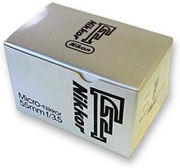 |
A matching PN-11 Extension tube enables this lens to reach 1:1 magnification ratio. The basic idea of the 105mm micro lens is similar to the 55mm Micro-Nikkor lens. It has magnification up to 0.5 (1/2 life size) without any accessories. The use of the dedicated extension ring extends the magnification from 0.5X to 1.0X (1:1 life size). |
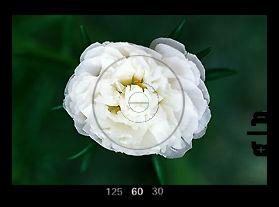 |
Differences of both versions of the Micro-Nikkor 105mm f/4.0 lens were confined only to their respective cosmetic rather than optical formulation (Compared the different rubberized focusing grips of the above two images). The latter version has a slightly more compact size than earlier one. During early '80 there was believed to have an Ai-S lens introduced at the later stages. |
Nikon Miicro-Nikkor lens family evolved again for the better during the early eighties, this time around both focal length of 55mm (Micro-Nikkor 55mm f/2.8s) and 105mm have been provided with a full f-stop brighter in their respective lens speed. (The process was a broad scope for Nikkor lens family as a whole and it was not confined solely to just the Micro-Nikkor lenses, for an instance, even Medical-Nikkor was upgraded in a entirely redesigned process). Naturally, the speed pump also has affected their respective optical compositions. Apart from that, all these Nikkor lenses have been upgraded with an Ai-S lens coupling system where a notch was added to provide additional information on focal length to suit a new range of Nikon multi-modes SLR cameras that provides Programmed and Shutter Priority AE and Matrix Metering system. However, there were only two manual focus Nikon SLRs that have truly benefited from such an "upgrading " of lens specification (Nikon FA and F301). Anyway, the upgrade was proven to be essential as the Ai-S spec was compatible with even many of the modern AF Nikon camera's exposure control system. On the other hand, the 200mm Micro-Nikkor lens was remained unchanged, where it was eventually being replaced with the AF version late in first quarter of the '90 by a worthy upgrade in the AF-D Micro-Nikkor 200mm f/4.0 ED-IF.
The speed gain in the Micro-Nikkor 105mm f/2.8s lens demands a revised optical design from its earlier straight forward composition in 5 elements in 3 groups to a more complex 9 elements in 8 groups design. Other than has a distinguishable Ai-S basic features and prominent minimum aperture at the aperture ring and ADR scale in a bright orange colour, the lens can be easily identify because it has a metallic distance lock knob at the side of the lens barrel.
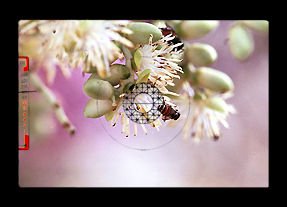 |
|
The range of magnifications available in Micro-Nikkor 105mm f/2.8s by adjustment of the lens built-in focusing control is 0.5X. The lens would seem to be a perfect upgrade from the earlier slower lens with its brighter f/2.8 maximum aperture but from a user point of view - a major drawback was still in its handling where it still needs a dedicated Auto Extension Ring PN- I I to enable it reaching life-size reproduction (1:1). In fact, that is the overall complaint I had for the MF series of Micro-Nikkor lenses as a whole. The lens has an extension of 52.5mm. It allows automatic full-aperture metering capability with any Ai-Spec Nikon bodies and usable with non-Ai bodies in stopped down metering. Other than the PN-11, there is also an older Auto Extension Ring PN-1 which is identical to the PN-11 in function, but this ring was originally designed to fits non-Ai lenses and thus, it is always safer to acquire a PN-11 extension tube if you have a Ai-Spec Nikon SLR camera to minimize chances of incompatibility. The lens built-in distance lock is equally well design for rapid pre-lock re-focusing. Lastly, unlike earlier version of the Micro-Nikkor f/4.0 which has a built-in telescopic lens hood design, there is a slight designing flaw with the f/2.8 lens that saw this lens requires a separate lens hood where it is supplied with a dedicated black metal HS-14 lens hood, reversed store on lens when not in use.
The next range of Micro-Nikkor is at 200mm focal length. I bought my Micro-Nikkor 200mm f/4.0 IF after Michael's strong recommendation which I find them very relevant at field works. The luxurious free working distance of 0.71m (2.34ft) between lens and object at its closest focusing distance is especially handy to use this lens for nature photography. The lens has a 9 elements in 6 groups design and has a narrower field view of 12° 20' which provides a more natural perspective than other Miicro-Nikkor lenses at close focus distance. This extension ring has a delightful design of a removable tripod mount built around the ring. By using the tripod socket on the extension ring instead of the one on the camera base, you can get a more balanced weight distribution (and not stressing the camera lens mount too). The collar rotates on the extension ring, with detents every 90'. It has a locking adjustment to hold any rotation so you can position the camera for a vertical shot, horizontal, or any angle. A built-in telescopic lens hood is provided which serves well for providing good lens shade.
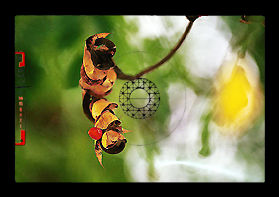 |
|
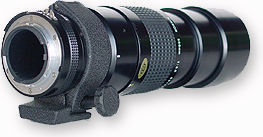 |
The Micro-Nikkor 200mm f/4.0 IF is a very well built lens, highly versatile for its purpose. The short fall, perhaps is its inability to go life size (1:1) while it would need to make use of a Nikon Teleconverter TC-300/301 to reach that magnification ratio ! |
| Previous | NEXT | MORE ....Compatibility with AF Nikkor, Non-Ai camera/lenses, conclusion etc. 2/3
Micro-Nikkor lense Family: | 50mm | 55mm (AF) | 60mm (AF) | 85mm PC | MF-105mm (AF) | MF-200mm (AF) | 70-180mm (AF) |
| Back | Main Index Page of Micro-Nikkor Lenses
| Message Board |
for
your Nikkor
Optics
in a shared environment
| Message
Board
| Specifically for Dispose or Looking for new/used Nikon/Nikkor
photographic equipment
| Nippon Kogaku Rangefinder Resources | Nikon F | Nikon F2 | Nikon F3 | Nikon F4 | Nikon F5 | Nikon F6 | Nikkormat / Nikomat | Nikon FM Series | Nikon FE/ FA | Nikon EM/FG/FG20 | Nikon Digital SLRs | Nikon - Other models |
Nikon MF RF-Nikkor lenses for Rangefinder
cameras:-
Main Index Page
Nikon
Auto Focus Nikkor lenses:- Main
Index Page
Nikon
Manual
Focus
Nikkor lenses:-
Fisheye-Nikkor Lenses - Circular |
Full Frame |
Ultrawides Lenses - 13mm15mm18mm20mm |
Wideangle Lenses - 24mm28mm35mm |
Standard Lenses - 45mm 50mm 58mm | Telephoto Lenses
- 85mm105mm135mm180mm & 200mm |
Super-Telephoto Lenses - 300mm 400mm 500mm 600mm 800mm 1200mm |
 |
Special Application
lenses: Micro-Nikkor Lenses - 50mm~55mm -60mm 85mm -105mm 200mm Micro-Zoom 70-180mm Perspective Control (PC) - 28mm 35mm PC-Micro 85mm Dedicated Lenses for Nikon F3AF: AF 80mm f/2.8 | AF 200mm f/3.5 EDIF Depth of Field Control (DC): 105mm 135mm Medical Nikkor: 120mm 200mm Reflex-Nikkor Lenses - 500mm 1000mm 2000mm Others: Noct Nikkor | OP-Nikkor | UV Nikkor 55mm 105mm | Focusing Units | Bellows-Nikkor 105mm 135mm Nikon Series E Lenses: 28mm35mm50mm100mm135mm | E-Series Zoom lenses: 36~72mm75~150mm70~210mm |
MF Zoom-Nikkor Lenses: 25~50mm | 28~45mm | 28~50mm | 28~85mm | 35~70mm | 36~72mm E | 35~85mm | 35~105mm | 35~135mm | 35~200mm | 43~86mm | 50~135mm | 50~300mm | 70~210mm E | 75~150mm E | 80~200mm | 85~250mm | 100~300mm | 180~600mm | 200~400mm | 200~600mm | 360~1200mm | 1200~1700mm
Tele-Converters: TC-1 | TC-2 | TC-200 | TC-201 | TC-300 | TC-301 | TC-14 | TC-14A | TC-14B | TC-14C | TC-14E | TC-16 | TC-16A | TC-20E
Recommended links to understand more technical details
related to the Nikkor F-mount and production Serial Number:
http://rick_oleson.tripod.com/index-153.html by: my
friend, Rick Oleson
http://www.zi.ku.dk/personal/lhhansen/photo/fmount.htm by: Hansen,
Lars Holst
http://www.mir.com.my/rb/photography/hardwares/nikonfmount/lens2.htm
http://www.photosynthesis.co.nz/nikon/serialno.html
Recommended Reading Reference on Nikon cameras and Nikkor lenses | about this photographic web site
| | Back | Main Index Page of Nikkor Resources | Back | Main Index Page of Pictorial History of Nikon SLRs |
| Home - Photography in Malaysia |
![]() Co-developed
with my web buddy, Rick Oleson® &
Co-developed
with my web buddy, Rick Oleson® & ![]() Denmark, Creator of the Nikon
Repair Group Mailing-List;
A
contributing effort to Michael Liu's Classic Nikon SLRs and
Nikkor optic site.
Denmark, Creator of the Nikon
Repair Group Mailing-List;
A
contributing effort to Michael Liu's Classic Nikon SLRs and
Nikkor optic site.
Credit: MCLau®, who has helped to rewrite
some of the content appeared this site. Chuck Hester® who has been helping
me all along with the development of all these Nikon websites; Lars Holst Hansen, 'Hawkeye'
who shares the same passion I have; Ms Rissa, Sales manager
from Nikon Corporation Malaysia for granting permission to use some of the official
content; Ted Wengelaar, Holland
who
has helped to provide many useful input relating to older Nikkor lenses; Some of the references
on production serial numbers used in this site were extracted from Roland Vink's website; Hiura Shinsaku from Nikomat
Club Japan. Lastly,
to all the good people who has contributed their own expeience, resources or kind
enough granted permission to use their images of their respective optic in this site.
It is also a site to remember a long
lost friend
on the Net. Note:certain content and
images appeared in this site were either scanned from official marketing leaflets
& brochures published by Nikon and/or contribution from surfers who claimed originality
of their work for educational purposes. The creator of the site will not be responsible
for may discrepancies arise from such dispute except rectifying them after verification. "Nikon", "Nikkormat", "Nippon Kokagu
KK"
& "Nikkor" are registered
tradename of Nikon Corporation Inc., Japan. Site made with an Apple IMac.
